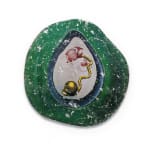Katja Novitskova
Earthware (de novo synthesis 001), 2020
digital print, synthetic clay, steel
50 3/4 x 49 1/4 x 1 5/8 in
129 x 125 x 4 cm
unique
129 x 125 x 4 cm
unique
De novo synthesis depicts life across micro and macro planes - it’s potential forms almost instantly becoming cultural fossils themselves. Employing digital data processing and elaborated filter mechanisms, Novitskova synthesizes...
De novo synthesis depicts life across micro and macro planes - it’s potential forms almost instantly becoming cultural fossils themselves. Employing digital data processing and elaborated filter mechanisms, Novitskova synthesizes organic shapes, patterns and poetic forms - harbingers of a post-human vision. Each of the egg shapes contains a figure, an abstracted embryo that lies in the center. During the embryonic state all of the major organs and structures of the growing body are formed. It’s both a state of complete vulnerability and one of unbelievable power, the strength of tenderness and pliancy.
With the use of machine learning algorithms and 3D modelling software, Katja Novitskova creates digitally rendered synthetic forms she then alters and composes. By feeding the algorithms with material from her image archive containing documentation images and sketches of her own work, but also visual research material related to biotechnology, images of laboratory animals, protein structures and viruses, shapes and patterns emerge that are organic but originatefrom complex digital image processing supported by artificial intelligence.
Some of the resulting shapes bring to mind works by Hilma af Klint, Georgia O’Keeffe and C.G. Jung. Novitskova extrapolates the visual proximity and mesmerizing poetry of said artworks by feeding some of their characteristic elements, like color scheme, into the algorithmic process.
“The resulting pieces appear as ancient clay tablets or wall fragments. They try to capture the poetics of numerical seeing as a timeless loop: from early human art to whatever hurricane of changes is happening at the present moment. " Katja Novitskova
With the use of machine learning algorithms and 3D modelling software, Katja Novitskova creates digitally rendered synthetic forms she then alters and composes. By feeding the algorithms with material from her image archive containing documentation images and sketches of her own work, but also visual research material related to biotechnology, images of laboratory animals, protein structures and viruses, shapes and patterns emerge that are organic but originatefrom complex digital image processing supported by artificial intelligence.
Some of the resulting shapes bring to mind works by Hilma af Klint, Georgia O’Keeffe and C.G. Jung. Novitskova extrapolates the visual proximity and mesmerizing poetry of said artworks by feeding some of their characteristic elements, like color scheme, into the algorithmic process.
“The resulting pieces appear as ancient clay tablets or wall fragments. They try to capture the poetics of numerical seeing as a timeless loop: from early human art to whatever hurricane of changes is happening at the present moment. " Katja Novitskova




